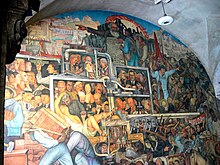Muralism


The term muralismo is a movement and art form that emerged in the 1920s after the Mexican Revolution . The Spanish name Murales describes wall painting in public spaces . The works reflect national, socially critical and historical content. The main tool is the paintbrush, but other techniques such as spray guns are also used. Most of the murals, however, are painted using the fresco technique.
history
José Vasconcelos in his former role as Secretario de Educación Pública is named as the initiator of the art movement . The government commissioned a group of artists with the aim of bringing the history of the country closer to the largely illiterate population, in particular the indigenous parts of Mexican culture and the progress of the country , through large, often monumental murals on prestigious public buildings . The first murales were created at the Escuela Nacional Preparatoria in Mexico City . The artists were almost free to present their content. Many images heroize the working and peasant people and their popular leaders, portray scenes of the revolution in a patriotic way, condemn large landowners and idealize the pre-Hispanic life of the indigenous people of the country.
The most important representatives were the so-called Los Tres Grandes ('The Big Three'), José Clemente Orozco , Diego Rivera and David Alfaro Siqueiros . Most Mexican murales painters were male. As the first representative of this physically demanding art form, Aurora Reyes Flores painted her portrayal of Atentado a los Maestros Rurales in 1936 . Many of the artists from Mexico known today were active on the left in politics, some of them also traveled through European countries, exchanged views with local artists and allowed themselves to be influenced in their further work by European art.
The advertising graffiti Bardas de Baile , which is widespread in Mexico, can be understood as a popular commercial variety of muralism.
Muralismo outside Mexico
Murales can be found on almost all public buildings in Mexico today. Under the name Muralismo, this art form spread over the course of the 20th century in many Latin American countries and later in Europe after the USA. In 1968 the first major wall painting in Germany was carried out at the “Große Freiheit” in Hamburg by the artists Werner Nöfer and Dieter Glasmacher . In the tradition of Mexican muralism, the French artist group CitéCréation has created over 500 facade works of art worldwide since it was founded in 1978 (as of 2011).
Muralismo in Italy
In Italy there is a large collection of wall paintings in Orgosolo , u. a. from Francesco Del Casino and in the “museum city” of San Sperate . In 1968 Pinuccio Sciola , influenced by Mexican artists such as David Alfaro Siqueiros , began to realize the first murales in San Sperate. The artist is also known as a sculptor of sound stones.
In Basilicata there are murals in Satriano by the artist Giovanni De Gregoro from the 18th century.
In the "Park of the Divine Comedy" (Valle delle Pietre Dipinte) in Campobello di Licata in the province of Agrigento there is a large literary park. At total of 110 monoliths of travertine , the artist Silvio Benedetto scenes of the Divine Comedy painted Dante.
literature
- National Gallery Berlin (Ed.): Wall - Image - Mexico . Fröhlich & Kaufmann, Berlin 1982, ISBN 3-88725-100-8 .
- Anna Indych-López: Muralism Without Walls - Rivera, Orozco, and Siquieros in the United States, 1927-1940 . University of Pittsburgh Press, Pittsburgh 2009, ISBN 978-0-8229-4384-6 .
Web links
- mural.ch Largest publicly accessible database on modern muralism with thousands of authors, addresses and literature
Individual evidence
- ↑ Luis-Martín Lozano, Juan Rafael Coronel Rivera: Diego Rivera. All murals. Taschen, Cologne u. a. 2008, p. 468f.
- ^ Mary Ann Sullivan, Bluffton College: Murals by Diego Rivera in the Palacio Nacional de Mexico - Index and Introduction.
- ↑ sardinien.com
- ↑ pecora-nera.eu
- ↑ medienbarone.de

